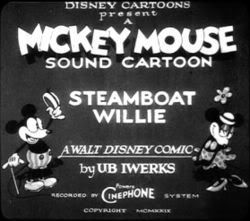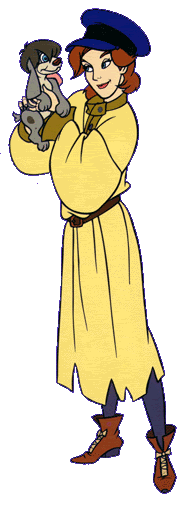
One more go-round of 'toon news you can use ... or wrap fish in.
You might remember Gnomeo and Juliet? The former Disney project about which Mr. Lasseter said: "Why are we making this?" when he first arrived at the Mouse House. Well, now the project is across the pond in Britain:
... Rocket initially brought "Gnomeo" to Walt Disney Feature Animation, but several years later the project was dropped by incoming Pixar executives John Lasseter and Ed Catmull. Miramax president Daniel Battsek, who followed the project while at Buena Vista International, persuaded Disney Studios chairman Dick Cook to revive it at his specialty division in April 2006.
Kelly Asbury will direct from an original script by Rob Sprackling and John R. Smith. Kevin Cecil, Andy Riley and Mark Burton have worked on later versions of the screenplay. Now in the storyboard stage, production is expected to be completed by 2010.
Director Asbury, of course, is a DreamWorks veteran who directed the second feature of the Shrek franchise.
As long as we're traveling the Disney highway, the L.A. Times has a piece on the question, "Is Mickey Mouse in the Public Domain, or is he not?" This is obviously a subject of some importance -- and ferocious defense -- by the Burbank conglomerate.
The ... debate, given its fullest form in a law review article by Douglas Hedenkamp, questions whether Mickey ever had a valid copyright to begin with, given the very strict rules then in effect about how the public had to be informed of copyright claims.
It centers on the title cards from the very first films with Mickey -- not just "Steamboat Willie" but two silent films that preceded it. The problem, from the company's perspective, is that Disney's name is not the closest to the word "Copyright." ...
Research and Markets analyzes the European animation industry:
Animation studios in European countries such as France and Spain have emerged as the market leaders in Europe. This is in part driven by the proactive steps taken by the governments of these countries by offering a range of tax breaks. The European animation studios started partnering to produce animation content for Television. These alliances resulted in content suited for local population. This is particularly seen in countries such as France, UK, Germany and Spain.
Toon Zone defends one of the fine, overlooked hand-drawn features of recent memory:
[The Sponge Bob Square Pants feature Atlantis Squarepants] has garnered some unusually negative reactions from hardcore fans and sneering professionals alike. After looking at Tom Shales's scathing review, it's time to return to the question I posed at the top of this piece: Who is its target audience? It's well known that a significant portion of viewers both in the US and the UK are adults; surely then, Shales concludes, this is partially aimed at adults. He seems to think that the secret to SpongeBob's success is the show's "satirical shenanigans". Having seen the program off and on since 1999, I find myself scratching my head as to what he means ...
Cartoon Brew floats the question, "Just what the hell is animation?" as it examines Year of the Fish, which calls itself "animated" but really ... uh ... isn't.

Year of the Fish is an indie film that opens next week in New York and San Francisco. I’m perplexed why the filmmakers are billing the film as an “animated feature film” when there is nothing remotely resembling animation in the trailer (watch it here). Movement that is created in real-time and then digitally-enhanced does not fit the definition of animation ...
This isn't difficult. These flicks and their cousins shouldn't be called "animation," but "rotoscope." Nothing wrong with rotoscope. Fleischer's Gulliver's Travels had an abundance of it, as did the more recent Anastasia. But roto isn't really animation, not in the sense we've thought about animation for seventy or eighty years. (Beyond Chron looks at the film's techniques and "animation process" -- that word again -- here.)
Gigacom notes how comic books are migrating to the web, and maybe becoming less comic-booky as they make the trip? ...
While sales of traditional entertainment forms like music CDs and DVDs have decreased or flattened, there hasn’t been a similar sea change forcing the comics industry to go digital — the paper-based comics business is still doing well. Combined sales of graphic novels and comic books in the U.S. and Canada hit $705 million in 2007 — a 10 percent bump up from 2006 — and sales of graphic novels have quintupled since 2001.
So if demand is still high for print, what’s driving the digital moves? Opportunity. “We want people to see these stories through as many distribution points as possible,” Buckley said ...
The company is also trying its hand at so-called motion comics, which use existing comic panels but give them an animated feel through pans and zooms or by giving characters simple movement; voice actors provide the dialog ...
"Motion comics"? Which is another word for "animatics," yes?
Have a fabulous weekend. Get out in the sunshine and play. But wear a broad-brimmed hat.




2 comments:
All I keep seeing the last few years is more and more animation jobs..on all levels..being sent overseas. Ireland, Canada, France, Germany..terrific for Europe, but what happens to skilled Americans?
I've seriously considered leaving the business but I fear anything I take on eventually will be outsourced.
I just can't get excited about the boom of animation in other countries, particularly if it involves work that has directly been taken out of my hands.
This is a discussion I have all the time.
I, personally, don't think all animation work is "going away" because it's not a zero sum game and studios tend to cluster where the talent pools are, be it a country or a geographic location (the east San Ferando Valley, the South Bay area of L.A.)
It's not just about costs, it's about availability of necessary skill sets. Southern California is always going to be impacted by the market place, exchange rates, tax policies, and so on, but there's more animation work in California right this minute than at any time in history.
Consider TAG the canary in the cage, far down the mine shaft. The only time we've had more active members or more hire slips was in the go-go middle nineties.
Post a Comment